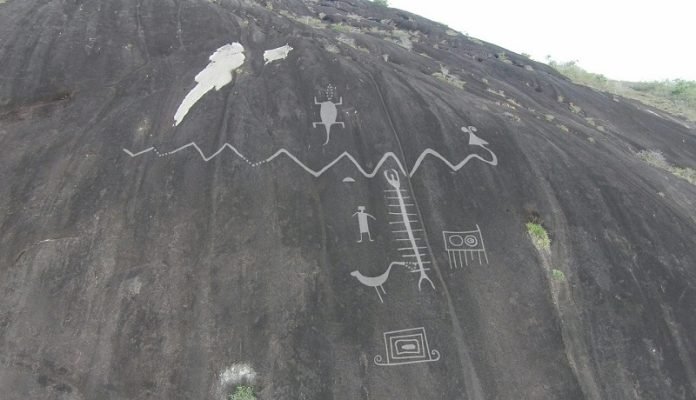
We weren’t the first to lay eyes on the engraving since it was carved into the hillside any number of centuries or millennia ago, not by a long shot.
The Venezuelan archaeologist José Maria Cruxent even recorded it in his diaries in the 1940s—and there were certainly visitors before him.
The site of Cerro Pintado (Painted Hill), in the Venezuelan state of Amazonas, is a local landmark and a well-known fixture on the itinerary of those traveling on the Middle Orinoco River.
Yet viewing the gigantic snake, carved high up on the hillside, immediately ignited both our sense of wonder and our scientific curiosity.
Why a snake?
Why did its creators climb a towering granite hill to place it there, just so? What about all the other engravings orbiting it—what do they mean?
All these questions and more swirled around our little group as we stood, sticky and mosquito-bitten, in the savanna at the foot of the hill. Its singular status made it all the more intriguing.
While there are other examples of giant prehistoric rock art in other parts of the world, these appear to be the largest. While, as mentioned, some were already known to archaeologists, our team documented others, including over the border in Colombia.
The results reveal a high concentration of these monumental engravings in the region. The subjects of these symbolic works include snakes, humans and centipedes.
The animals probably played an important role in the mythologies of the people who made them. The results have been published in the journal Antiquity.
New sites to survey
On our visit to Cerro Pintado in 2015, we supposed that the enormous 42-meter-long snake engraving (probably representing a boa or anaconda, native to the region) stood in splendid isolation.
Prior scholars observed that many rock shelters in the surrounding savanna hosted prehistoric paintings, and we had already seen plenty of engravings near our dig sites.
Although often numerous or quite large, none of these sites shared the truly monumental scale of the Cerro Pintado engravings. Its apparent uniqueness led us to dutifully return with a drone to secure better images of the highly inaccessible panel. Already during the first stint in the field, however, we suspected that there was more to be uncovered about the rock art of the region.
Our guide, Juan Carlos García, a local educator and photographer, was well traveled around the area, and had plenty of insights to share. While surveying the islands that separate the calm middle course of the Orinoco River from its turbulent upper reaches, he pointed to the Colombian bank and forthrightly informed us: “Do you see that hill? Over there, behind it, is another snake, as big as Pintado.”
The possibility of another snake was beyond tantalizing to us. Did it also have a set of accompanying motifs?
Was it truly as big and as visible from far away? For lack of scientific permits in Colombia, or the time to search for a new site even if we had permits, these questions were left unanswered.
After four campaigns in Venezuela, our fieldwork funding ended in 2017 and Cerro Pintado remained, as far as archaeology was concerned, a one-and-only location.
Written by Philip Riris, José R. Oliver and Natalia Lozada Mendieta, The Conversation



